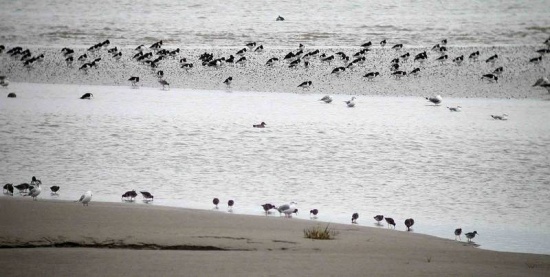| This article is incomplete. This article is missing one or more sections. You can help the BirdForum Opus by expanding it. |
Overview
Supporting Britain's largest population of wintering waders, this is one of the most important areas for birds in the country.
The reserve consists of large areas of intertidal mudflats, behind which are saltmarshes backed by shingle beaches and cliffs at Silverdale.
Warning signs and flags should be heeded at all times as the sands can be dangerous due to shifting areas of quicksand. If you are in any doubt, stick to paved areas.
Birds
Notable Species
Waders can be seen all year but numbers and variety are lowest in midsummer. During passage periods and winter there are outstanding numbers of waders in the bay. Oystercatcher, Red Knot, Dunlin, Eurasian Curlew and Bar-tailed Godwit are among the most numerous but Common Redshank, Northern Lapwing, Grey and Ringed Plovers and Turnstone also occur in large numbers with Whimbrel in autumn and Sanderling in spring. As well as waders various species of waterfowl occur including Common Shelduck, Eurasian Wigeon, Northern Pintail and Northern Shoveler.
On the sea Great Crested Grebe and seaducks such as Common Goldeneye and Red-breasted Merganser are regular. In winter these flocks are harried by Peregrine Falcon and Merlin, Short-eared Owl patrols for small mammals and the estuarine creeks usually hold Common Kingfisher.
Breeding birds of the area include Oystercatcher, Northern Lapwing and Common Redshank and occasionally Dunlin. These species nest on the saltmarsh area between the mudflats and the beach which is flooded during the highest spring tides. Also breeding here are Black-headed Gull, small numbers of Lesser Black-backed Gull and occasionally Great Black-backed Gull, Eurasian Skylark and Meadow Pipit.
Check-list
Birds you can see here include:
Red-throated Diver, Great Crested Grebe, Great Cormorant, Grey Heron, Bewick's Swan, Greylag Goose, Common Shelduck, Eurasian Wigeon, Common Teal, Mallard, Northern Pintail, Northern Shoveler, Greater Scaup, Common Eider, Common Scoter, Common Goldeneye, Long-tailed Duck, Goosander, Red-breasted Merganser, Merlin, Eurasian Sparrowhawk, Peregrine Falcon, Eurasian Oystercatcher, Ringed Plover, Eurasian Golden Plover, Grey Plover, Northern Lapwing, Red Knot, Sanderling, Little Stint, Curlew Sandpiper, Purple Sandpiper, Dunlin, Bar-tailed Godwit, Whimbrel, Eurasian Curlew, Ruff, Spotted Redshank, Common Redshank, Common Greenshank, Green Sandpiper, Wood Sandpiper, Common Sandpiper, Ruddy Turnstone, Black-headed Gull, Common Gull, Lesser Black-backed Gull, European Herring Gull, Great Black-backed Gull, Short-eared Owl, Common Kingfisher, Eurasian Skylark, Meadow Pipit, Northern Wheatear, Carrion Crow, Common Starling
Other Wildlife
For botanists the carboniferous limestone cliffs at Silverdale are of great interest with a variety of colourful flowers such as Bloody Cranesbill, Horseshoe Vetch, Birdsfoot Trefoil, Sea Campion, Rock Rose and Harebell. Areas of shingle beach are brightened by large numbers of Yellow Horned Poppy.
Site Information
History and Use
To do
Areas of Interest
To do
Access and Facilities
Morecambe Bay is situated in Lancashire and the RSPB reserve lies in the north of the bay between Hest Bank and Silverdale. The reserve can be reached by leaving the M6 at either Junction 34 or 35.
The bay is best viewed from Hest Bank off the A5105 Morecambe-Carnforth road where there is a hide. There are also hides overlooking a lagoon on Carnforth saltings close to Leighton Moss.
Other Sites Nearby
The Leighton Moss reserve is very close at Silverdale.
Recommended Citation
- BirdForum Opus contributors. (2025) Morecambe Bay. In: BirdForum, the forum for wild birds and birding. Retrieved 13 May 2025 from https://www.birdforum.net/opus/Morecambe_Bay
External Links
Content and images originally posted by Steve
Reviews
jinglebird's review
good. wady Pros
- waders
Cons
- none




